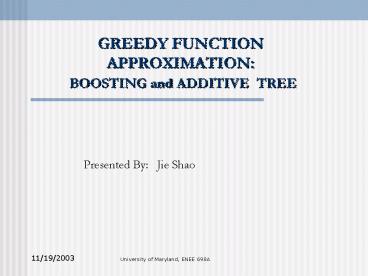GREEDY FUNCTION APPROXIMATION: BOOSTING and ADDITIVE TREE - PowerPoint PPT Presentation
1 / 19
Title:
GREEDY FUNCTION APPROXIMATION: BOOSTING and ADDITIVE TREE
Description:
Committee of trees (boosted) model. Optimization Criterion. 11/19/2003 Wednesday ... Boosting Tree. Greedy Strategy: Steepest-descent ... – PowerPoint PPT presentation
Number of Views:524
Avg rating:3.0/5.0
Title: GREEDY FUNCTION APPROXIMATION: BOOSTING and ADDITIVE TREE
1
GREEDY FUNCTION APPROXIMATION BOOSTING and
ADDITIVE TREE
- Presented By Jie Shao
2
Roadmap
- Detour introduction of boosting
- Boosting Trees
- Numerical Optimization
- Right-sized Trees for Boosting
3
Background Ensemble learning
- Some useful results
- Combines multiple learned models to construct
better generalizations - Classifiers that always agree wont give new
information - Combining predictions of an ensemble will often
be more accurate than any of single prediction. - Ideal learning ensemble individually accurate
classifiers with high level of disagree - Applications bagging, boosting
- Reason?
- Small training data, large hypothesis space.
- Many possible classifiers remain with equal
accurate - Compensate for non-optimal search (several local
solutions)
4
Boosting
- Why called boosting it always attempts to boost
the accuracy of any given learning algorithm,
whatever weak it is. (A weak learner is a learner
which performs just slightly better than
coin-flip does.) - Motivation combines the outputs of many weak
classifiers to produce a powerful committee . - Strategy fits model with a set of elementary
basis functions in an additive way. - General form
5
Performance Improvements of Boosting
- Generates a hypothesis whose error on the
training set is small by combining many
hypotheses with large errors. - Reality training data exhibit different degrees
of hardness. - Each learning algorithm has unstable behavior,
i.e, appears sensitive to changes in training
data. - Reduces both variance and bias, while bagging can
only significantly reduces variance.
6
Boosting Trees
- General tree definition
- Committee of trees (boosted) model
- Optimization Criterion
7
Boosting Trees (contd)
- If we already know splits , finding
will be quite easy for any loss function. - Finding is difficult, typical strategy
is to use a greedy, top-down recursive
partitioning algorithm. - It is straightforward to the equation might have
some simple forms when the loss function is
squared error or exponential. - Otherwise, we need to use numerical method for
optimization.
8
Numerical Optimization
- Fast approximate algorithms for solving
optimization equation with any differentiable
loss criterion can be derived by analogy to
numerical optimization - Loss function
- Goal minimize with respect to , where
here - is constrained to be a sum of trees.
- Recap numerical optimization
9
Greedy Strategy Steepest-descent
- Steepest-descent is one of the simplest of the
frequently used numerical minimization methods. - Gradient descent search (line search along the
steepest direction) to minimize the loss on
training data
10
Gradient Boosting
- The approach is analogous to line search in
steepest descent, it performs a separate line
search for tree components corresponding to each
separate terminal region in each iteration. - Q Why not just use steepest descent?
- A We need generalize to whole data space, not
only training data, to which steepest descent is
feasible to find the optimal.
11
Gradient Tree Boosting Feasible Approach
- Induce a tree at the mth iteration,
make the predictions of which as close as
possible to the negative gradient. - Using squared error
- More robust, less likely to be over fitting.
12
Algorithm MART (Multiple Additive Regression
Trees)
- Intialize
- For m1M
- For I1,..,N, compute
- Fit regression tree to target giving region
, j1,2,..,Jm - Compute
- Update
- Output
13
Remarks for MART
- Initialization step model is just a single
terminal node tree. - Parameters associated with MART procedure are
- Number of iteration M
- Sizes of each of the constitute trees Jm
- Gradient search operated in a constrained
function space, each component is a tree.
14
Discussion on Tree Size for Boosting
- Tree building algorithm was regarded as a
primitive to produce models to be combined by
boosting. - During each iteration
- Oversized tree pruned by bottom-up
procedure - The best for one step is not the best in the long
run. - Disadvantages
- Degrade performance
- Increase computation
15
Right-Sized Trees for Boosting
- Strategy restrict all trees to be the same size
. - Adjust to maximize estimated performance
for the data at hand. - Useful property of tree size
- Limits the input feature interaction level of the
tree-based approximation. - i.e. No interaction effects of level greater than
- are possible.
16
Estimate Tree Size via Interactive Level
- Target function
- The degree of coordinate variable interact with
one another can be captured by ANOVA expansion - In practice, low-order interaction effects tend
to dominate, empirical results indicate - works well.
17
(No Transcript)
18
Conclusion
- We introduce a machine learning method boosting
- Boosting tree is a tree-modeled boosting method.
- Several numerical optimization methods are
discussed for tree prediction. - MART is a state-of-the-art algorithm.
- When tuning parameter of tree size, the simplest
way is right-sized tree method.
19
References
- Jerome H. Friedman(IMS 1999 Reitz Lecture)
- Greedy Function Approximation A Gradient
Boosting Machine - Jerome H. Friedman(1999) Stochastic Gradient
Boosting - www.boosting.org































